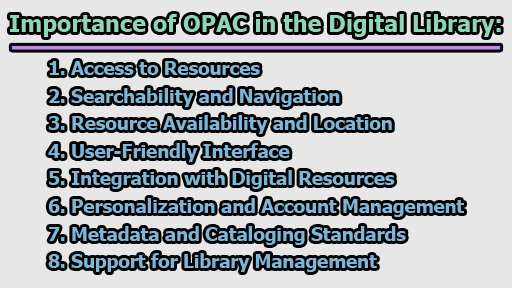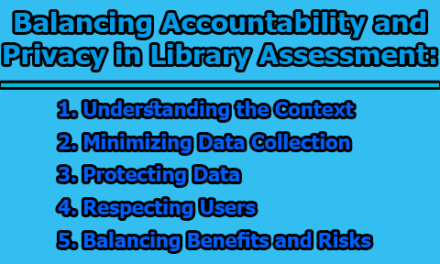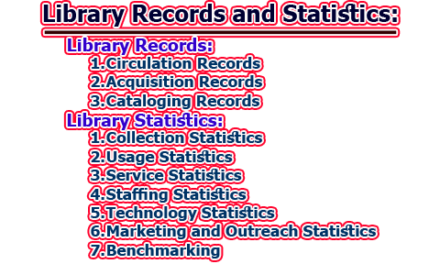Importance of OPAC in the Digital Library:
OPAC, or Online Public Access Catalog, plays a crucial role in the digital library environment. It serves as the gateway for users to access and retrieve information from the library’s collection. Here are some of the key importance of OPAC in the digital library:
1. Access to Resources:
- Remote Access: OPAC facilitates remote access to the digital library’s resources, enabling users to explore and utilize the collection from anywhere with an internet connection. This is particularly beneficial for distance learners, researchers, and individuals who cannot physically visit the library.
- Comprehensive Collection: Users can access a diverse range of materials through OPAC, including books, journals, articles, multimedia, and digital resources. The catalog serves as a centralized platform where the entire spectrum of the library’s holdings is made accessible to users, ensuring that they can discover a wide array of information.
- Enhanced Accessibility: OPAC often incorporates features such as adjustable font sizes, language preferences, and accessibility tools, making it inclusive for users with diverse needs. This accessibility is crucial in catering to a broad user base, including individuals with visual or cognitive impairments.
2. Searchability and Navigation:
- Advanced Search Functionalities: OPAC provides advanced search options, allowing users to refine their queries based on specific parameters such as author, title, subject, keywords, publication date, and more. This helps users conduct targeted searches, saving time and providing more accurate results.
- Faceted Search: Some OPAC systems incorporate faceted search, enabling users to filter search results dynamically. Users can refine their searches based on facets like format, language, location, and availability. This helps users narrow down their focus and find the most relevant resources.
- User-Friendly Interface: The interface is designed to be user-friendly, ensuring that individuals with varying levels of technological proficiency can navigate the catalog effortlessly. Intuitive navigation menus, clear labels, and visual cues contribute to a positive user experience.
3. Resource Availability and Location:
- Real-Time Availability: OPAC provides real-time information on the availability of resources. Users can check whether a specific item is currently available on the shelf, checked out, or in the process of being cataloged. This real-time status helps users plan their visits or make informed decisions about resource selection.
- Location Details: For physical collections, OPAC provides precise information about the location of resources within the library. This includes shelf numbers, floor details, and other navigational cues to guide users to the exact spot where they can find the desired material.
- Online Links: In the case of digital resources, OPAC often includes direct links to online content. Users can access e-books, journal articles, or multimedia materials with a single click, streamlining the process of obtaining digital information.
4. User-Friendly Interface:
- Intuitive Design: OPAC is designed with user experience in mind, featuring an intuitive interface that accommodates users with varying levels of technological expertise. Clear and logically organized menus, buttons, and search fields contribute to an interface that is easy to understand and navigate.
- Responsive Design: Many OPACs are designed to be responsive, ensuring compatibility with various devices such as desktops, laptops, tablets, and smartphones. This responsiveness enhances accessibility, allowing users to access the catalog seamlessly from different devices.
- Customization Options: Some OPAC systems offer customization options, allowing users to personalize their experience. This may include features like saved searches, favorites, and personalized lists, enabling users to tailor the catalog interface to their specific needs and preferences.
5. Integration with Digital Resources:
- Seamless Access to Electronic Materials: OPAC seamlessly integrates with digital resources such as e-books, electronic journals, databases, and multimedia content. Users can access these materials directly through the catalog interface, eliminating the need for separate platforms or logins.
- Expanded Access: Integration with digital resources expands the scope of available materials beyond traditional print collections. Users can benefit from a wealth of electronic content, fostering a more comprehensive and up-to-date library collection.
- User Authentication: In many cases, OPAC incorporates user authentication systems to ensure secure access to licensed digital resources. This feature helps libraries control and monitor access, particularly for materials that may have restricted usage.
6. Personalization and Account Management:
- User Accounts: OPAC often allows users to create accounts, enabling them to personalize their experience. User accounts may offer features such as saved searches, bookmarking, and personalized lists, contributing to a more tailored and efficient user experience.
- Browsing History: Users can track their borrowing history and review previously accessed materials through their accounts. This feature helps users manage their reading or research activities, making it easier to revisit relevant resources.
- Notifications and Alerts: Some OPAC systems provide users with the option to set up notifications or alerts for new acquisitions, upcoming due dates, or other relevant library information. This proactive communication enhances user engagement and awareness.
7. Metadata and Cataloging Standards:
- Consistency in Resource Description: OPAC relies on standardized metadata and cataloging practices to ensure consistency and accuracy in resource description. Metadata, such as title, author, subject, and keywords, follows established standards like MARC (Machine-Readable Cataloging), facilitating clear and uniform representation of library holdings.
- Interoperability: adherence to cataloging standards enhances interoperability between different library systems. Libraries can share cataloging records, making it easier to exchange information and collaborate on resource management.
- Enhanced Discoverability: Well-cataloged materials contribute to enhanced discoverability. Users can find relevant resources more easily, and librarians can efficiently manage and organize the library’s collection.
8. Support for Library Management:
- Inventory Control: OPAC is an integral part of library management systems, aiding librarians in inventory control. It tracks the status of items, helping libraries monitor the circulation, availability, and condition of materials.
- Statistical Reporting: OPAC generates data that supports statistical reporting and analysis. Librarians can derive insights into usage patterns, popular resources, and other metrics, informing collection development decisions.
- Decision-Making Processes: The data generated by OPAC assists librarians and administrators in making informed decisions about acquisitions, resource allocation, and service enhancements. This contributes to the overall strategic planning and development of the library.
In conclusion, OPAC is a fundamental tool in the digital library landscape, providing users with seamless access to a wide array of resources while supporting efficient library management. Its user-friendly interface, advanced search capabilities, and integration with digital resources contribute to a more effective and accessible library experience for both patrons and library staff.

Library Lecturer at Nurul Amin Degree College










